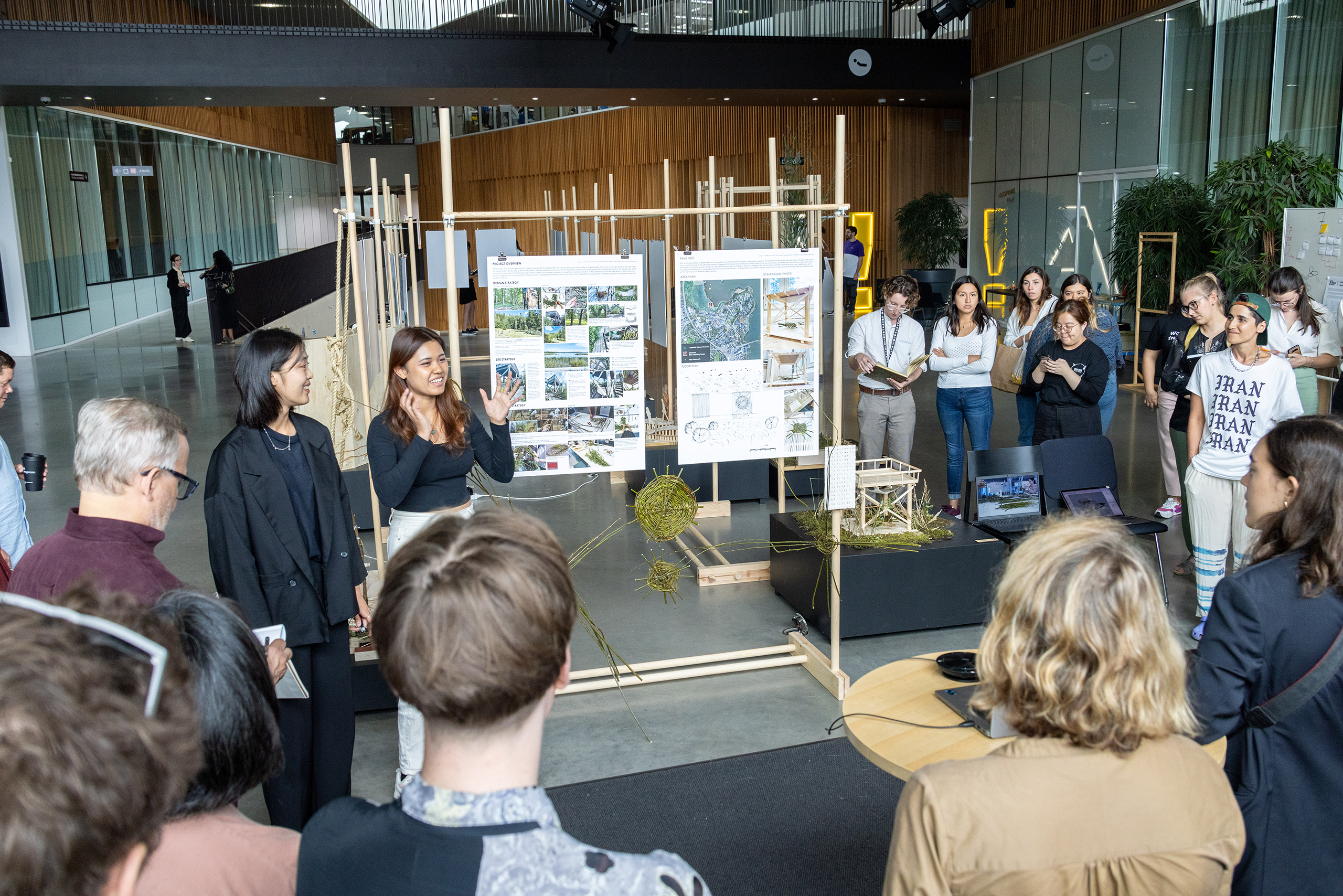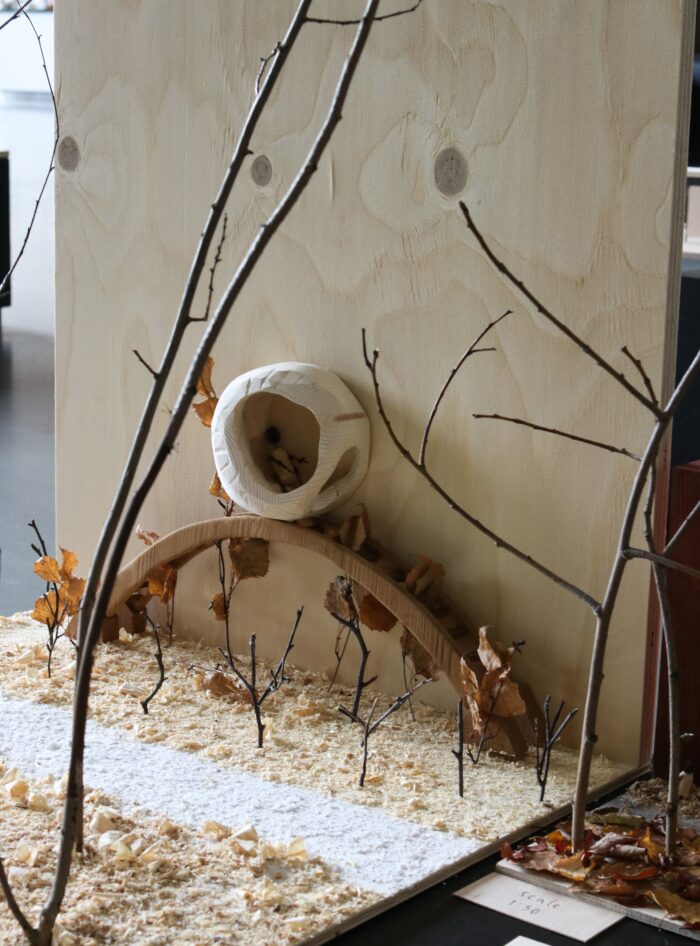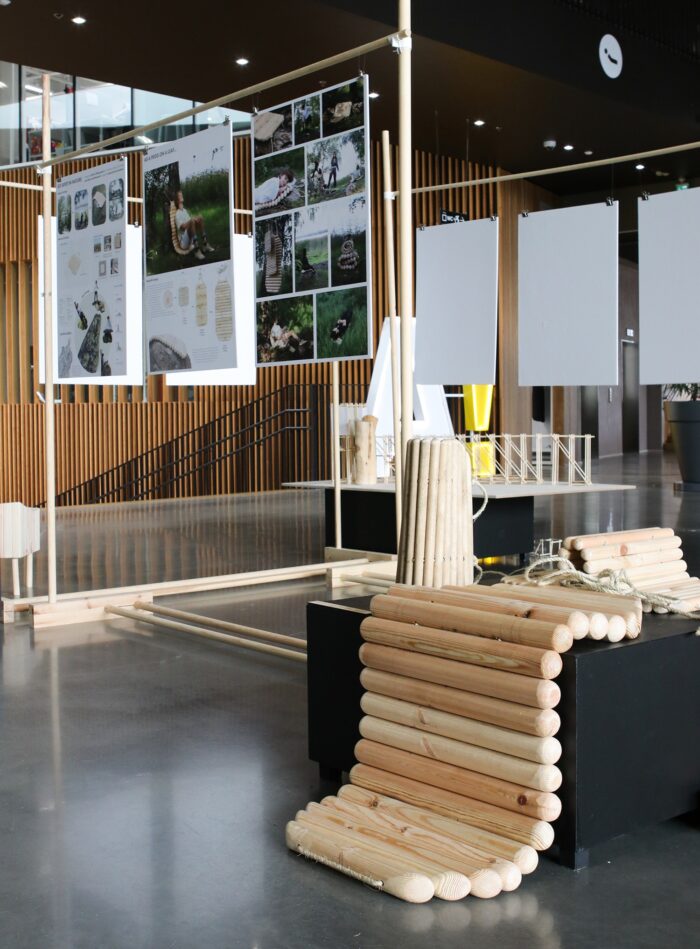Aalto Summer School went further than the wood(s)
Aalto University ARTS Summer School brought together students from ten universities of the arts on three continents. When designing wooden structures, the students soon discovered that the Finns far from lose out to the best in the world.

Photos: Tiina Otala and Mikko Raskinen, Summer School Exhibition/Aalto University
To the north, the Otaniemi campus opens out onto Laajalahti, where a walk along the shoreline is a great way to relax in everyday university life.
However, as Persephone Cooper and others in her team noticed when they discovered the shoreline during their time at Aalto ARTS Summer School, there’s an obstacle between the water and the walker. The impenetrable bed of reeds higher than humans growing at the water’s edge.
Fortunately the team had a solution ready.
“Wooden walkways could be built to the water’s edge so that people could walk through and over the reeds. There would be pavilions to sit in at suitable places,” is how Cooper explains her team’s idea in the exhibition held on the last day of the summer school.
The plan is illustrated not only by a 3-D map made of wood, but also by a full-scale example pavilion. The pavilion bench was ingeniously made of reeds. While they creak forebodingly under the person sitting on them, they do last. If the plan becomes a reality, the benches would be made from the reeds cleared to make the paths.

Five countries join forces
It sounds ambitious, but nothing less could be expected of this crowd. Cooper studies history of design at the Royal College of Art in London. She made the plan as part of a team whose members included architecture and design students. The other members in the team came from Finland, Mexico, Norway and Singapore.
The two-week ARTS Summer School brought them and 38 other students to Otaniemi in August. Students were divided into ten teams at Aalto University ARTS Summer School and at the end of the two weeks, each team presented its own idea.
“Creating something to this timetable was challenging but also inspiring. For example, I got to try wood burning while making the legs, which was a very interesting experience, ” says Christina Sund, a Norwegian architect student in the team.
“Everything we wanted to try was successful and everyone in the work facilities was very helpful. We don’t have such good resources in Oslo.”
Wooden designs for the campus
This was second ARTS Summer School. This year’s theme was Living With Wood(s), or building with wood in a sustainable way.
The assignment was to design something of wood for the Otaniemi campus. The exhibition of final works featured a miniature model of a sculptural tram stop built from wood, a concept for a relaxation space built around a tree, an observation platform resembling a bird’s nest built from willow and many other things.
Most of the students at the summer school were architects. Nevertheless, the handprint of designers and other people in applied arts is reflected in for example in the seats made of sticks and strings and the sanded benches of logs.
All the work was done in less than two weeks and the international teams hadn’t even met each other earlier.
Work was done to the last moment and not everything always went to plan. For example, the reed bench should also have had a back but not enough reeds were collected for this.
Empty premises put to use
Tuomas Auvinen, Dean, School of Arts, Design and Architecture at Aalto University, came up with the idea for the Arts Summer School. Auvinen says that there were two main reasons. The first was to use working premises that are little used during the summer. The other was to give students a perspective to other top universities in the field of arts.
“Aalto is a world leader in our field: we were in sixth place in the most recent ranking. All the same, students easily get a feeling that we’re here in the far North and that the best students study in London or New York. The summer school gives our own students an opportunity to work with students from these other universities and realise that we’re at just the same level.”
Closer cooperation between universities is also part of the summer school idea. Besides Aalto, nine universities from Delft, London, Mexico, Milan, New York, Oslo, Singapore, Versailles and Warsaw are also involved.
Teachers from around the world
It’s not just students from around the world who get together but also teaching staff. One or more teachers from each of the participating universities also comes to the summer course. The teachers guide the teams, assess the end results and give lectures.

Jeongi Lim, who teaches at Parsons School of Design in New York, is at the summer school for a second time. He considers the international atmosphere of the summer school to be very inspiring.
“Last year I listened with interest to a Singaporean colleague’s thoughts on post-humanist architecture, which considers nature on a broader scale than humans. This year we gave a lecture on the subject together.”

We’re also planning a joint article.
Lim says the students as well are enthusiastic about the summer school.
“It’s so easy to think that we have everything in New York and yet dozens of students applied for the school. Only four were selected.”
Initial impetus supported by the Foundation
There is only once question as far as the summer school is concerned – funding.
Even though the participating schools pay for the participants’ trips, Aalto provides the facilities, accommodation, a large share of the teaching and the excursions. The summer school is not run out of Aalto’s budget but with funding received from the Jane and Aatos Erkko Foundation.
“It’s much easier to build something new when the funding is clear. It’s easier for others to commit when there’s certainty that it will go ahead,” Auvinen says.
As it stands, the Foundation will continue funding for four years.
“Things will then have to be revisited. However, the situation then will already be much easier since many schools have noticed that the summer school is a viable project.”